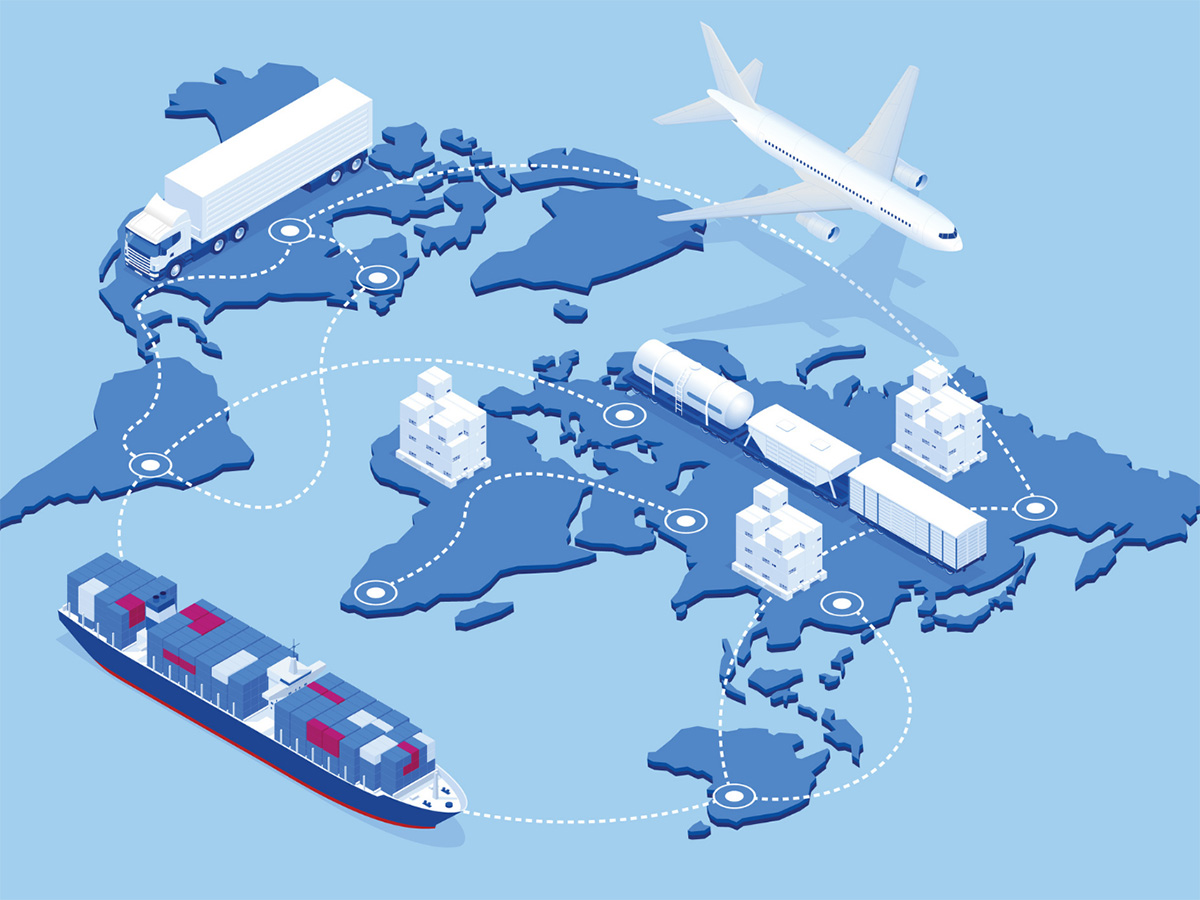

Finance
What Is An Agile Supply Chain?
Published: October 19, 2023
Learn about the importance of an agile supply chain in the finance industry and how it can revolutionize your business operations.
(Many of the links in this article redirect to a specific reviewed product. Your purchase of these products through affiliate links helps to generate commission for LiveWell, at no extra cost. Learn more)
Table of Contents
- Introduction
- Definition of an Agile Supply Chain
- Characteristics of an Agile Supply Chain
- Benefits of Implementing an Agile Supply Chain
- Key Components and Strategies for Building an Agile Supply Chain
- Challenges and Risks Associated with Adopting an Agile Supply Chain
- Case Studies and Examples of Successful Agile Supply Chains
- Conclusion
Introduction
Welcome to the world of finance and the fascinating topic of agile supply chains. In today’s fast-paced and ever-changing business landscape, organizations must adapt and evolve to stay competitive. The concept of agility is no longer limited to software development; it has now become a crucial strategy for supply chain management.
An agile supply chain is a dynamic and flexible approach that enables companies to respond swiftly to market changes, customer demands, and disruptions. It focuses on optimizing efficiency, reducing costs, and enhancing customer satisfaction by embracing agility in every aspect of the supply chain process.
In a rapidly evolving marketplace, organizations must be able to quickly adjust their production, distribution, and logistics operations to meet shifting customer preferences and market trends. By embracing an agile supply chain, companies can achieve greater responsiveness, adaptability, and resilience, even in the face of unforeseen challenges.
With the advancement of technology and the rise of e-commerce, customer expectations have skyrocketed. Customers now demand faster delivery times, personalized products, and seamless shopping experiences. To meet these demands, organizations must adopt an agile supply chain that is capable of meeting these dynamic market requirements.
In this article, we will delve deeper into the concept of an agile supply chain, exploring its definition, characteristics, benefits, key components, strategies, challenges, and successful examples. By the end of this article, you will have a comprehensive understanding of what an agile supply chain entails and how it can revolutionize the way organizations approach supply chain management.
Definition of an Agile Supply Chain
An agile supply chain can be defined as a responsive and adaptable network of interconnected activities involved in the production, procurement, transportation, and distribution of goods and services. It is a holistic approach that emphasizes flexibility, speed, and collaboration to meet the ever-changing demands of the market.
Unlike traditional supply chains that are rigid and centralized, an agile supply chain is characterized by its decentralized structure, quick decision-making capabilities, and cross-functional collaboration. It focuses on anticipating and responding to fluctuations in demand, market trends, and unforeseen events in real-time.
At the core of an agile supply chain is the ability to quickly adapt and reconfigure its operations to effectively manage uncertainties and ensure customer satisfaction. This requires seamless information flow, efficient coordination among stakeholders, and the integration of advanced technologies and digital solutions.
Agility in the supply chain is not solely limited to speed or responsiveness. It also encompasses the ability to mitigate risks, optimize costs, and maintain a high level of customer service. By implementing an agile supply chain, organizations can optimize their inventory levels, reduce lead times, and enhance their ability to customize products according to customer needs.
Key elements of an agile supply chain include:
- Collaboration: Emphasizing close collaboration among suppliers, manufacturers, distributors, and customers to share information, insights, and resources.
- Adaptability: Being able to quickly adjust production schedules, distribution channels, and logistics operations to respond to changes in demand, market conditions, and disruptions.
- Visibility: Ensuring real-time visibility and transparency across the supply chain to enable proactive decision-making and identify potential bottlenecks or risks.
- Innovation: Encouraging a culture of continuous improvement and innovation to drive operational excellence, optimize processes, and foster a competitive advantage.
Overall, an agile supply chain is a strategic approach that enables organizations to successfully navigate the complexities and uncertainties of the modern business environment by embracing flexibility, collaboration, and continuous improvement. It is a transformative mindset that can revolutionize supply chain management and drive sustainable growth in the digital era.
Characteristics of an Agile Supply Chain
An agile supply chain is distinguished by several key characteristics that enable organizations to effectively respond to market dynamics and customer demands. These characteristics help organizations achieve flexibility, speed, and efficiency in their supply chain operations. Let’s explore some of the key characteristics of an agile supply chain:
- Flexibility: An agile supply chain is highly flexible and can quickly adapt to changes in customer preferences, market trends, and disruptions. It allows organizations to adjust production volumes, shift manufacturing locations, and modify distribution channels in response to evolving circumstances.
- Collaboration: Collaboration is a fundamental aspect of an agile supply chain. It involves close coordination and information sharing among suppliers, manufacturers, distributors, and customers. Effective collaboration helps streamline processes, enhance visibility, and ensure smooth operations throughout the supply chain.
- Information Transparency: An agile supply chain relies on real-time visibility and transparency of information. Organizations leverage advanced technologies, such as supply chain management software and IoT devices, to capture and analyze data. This enables them to make informed decisions, identify potential bottlenecks, and proactively address any issues that may arise.
- Risk Management: Agility in the supply chain involves proactive risk management. Organizations analyze potential risks and develop contingency plans to mitigate their impact. They also build resilient supplier networks and establish backup plans to minimize disruptions in the event of unforeseen circumstances.
- Customer-Centricity: An agile supply chain places the customer at the center of its operations. It aims to meet and exceed customer expectations by offering personalized products, shorter lead times, and excellent customer service. Organizations adopt customer-centric strategies and leverage data analytics to understand customer preferences and deliver tailored solutions.
These characteristics enable organizations to achieve several important outcomes. By embracing flexibility, collaboration, information transparency, risk management, and customer-centricity, organizations can attain the following benefits:
- Reduced lead times
- Improved customer satisfaction
- Lower inventory costs
- Enhanced operational agility
- Reduced supply chain disruptions
- Increased market responsiveness
- Optimized utilization of resources
- Improved forecasting accuracy
Overall, the characteristics of an agile supply chain enable organizations to proactively address market changes, enhance customer experiences, and gain a competitive edge in today’s dynamic business environment.
Benefits of Implementing an Agile Supply Chain
Implementing an agile supply chain can bring a wide range of benefits to organizations. By embracing agility and flexibility in their supply chain operations, companies can gain a competitive advantage and achieve sustainable growth. Let’s explore some of the key benefits of implementing an agile supply chain:
- Improved Responsiveness: An agile supply chain enables organizations to quickly respond to market changes, customer demands, and unforeseen disruptions. By having the ability to adapt their production schedules, inventory levels, and distribution channels, companies can meet shifting customer expectations and capitalize on emerging opportunities.
- Reduced Costs: Agility in the supply chain allows organizations to optimize their inventory levels, reduce lead times, and minimize waste. By having a more accurate demand forecasting and efficient production and distribution processes, companies can significantly reduce carrying costs, inventory obsolescence, and operational expenses.
- Enhanced Customer Experience: An agile supply chain enables organizations to offer personalized products, shorter lead times, and improved customer service. By understanding customer preferences and leveraging real-time data, companies can tailor their offerings to individual needs, provide faster order fulfillment, and deliver an exceptional customer experience.
- Increased Market Competitiveness: Companies with an agile supply chain are better equipped to handle market dynamics and outperform their competitors. By being able to quickly introduce new products, respond to changing customer demands, and seize market opportunities, organizations can gain a significant competitive advantage and enhance their market share.
- Enhanced Risk Management: Agility in the supply chain allows organizations to proactively manage and mitigate risks. By having a flexible and transparent supply chain, companies can quickly identify and address any potential disruptions or bottlenecks. They can also establish backup plans, build resilient supplier networks, and minimize the impact of unforeseen events.
- Innovation and Collaboration: An agile supply chain fosters a culture of innovation and collaboration across the organization. By encouraging cross-functional teamwork, knowledge sharing, and continuous improvement, companies can drive operational excellence, efficiency, and innovation throughout the supply chain process.
By reaping these benefits, organizations can achieve long-term growth, customer loyalty, and financial success. However, it’s important to note that implementing an agile supply chain also comes with its own set of challenges and risks. In the next section, we will explore these challenges and provide strategies for successfully implementing an agile supply chain.
Key Components and Strategies for Building an Agile Supply Chain
Building an agile supply chain requires careful planning, coordination, and implementation of various key components and strategies. These components and strategies form the foundation of an agile supply chain and enable organizations to achieve flexibility, responsiveness, and efficiency. Let’s explore some of the essential components and strategies for building an agile supply chain:
- Supply Chain Visibility: Establishing real-time visibility across the supply chain is crucial for agile operations. This involves implementing technologies such as sensors, RFID tags, and supply chain management software to track inventory, monitor production, and identify potential bottlenecks. With complete visibility, organizations can proactively respond to disruptions and make informed decisions.
- Collaborative Relationships: Developing strong partnerships and collaborative relationships with suppliers, distributors, and other stakeholders is key to building a resilient and agile supply chain. By sharing information, collaborating on demand planning, and coordinating production and distribution schedules, organizations can enhance their responsiveness and optimize their operations.
- Flexible Manufacturing: Implementing flexible manufacturing practices allows organizations to quickly adapt to changing demand patterns and market conditions. This includes investing in technologies such as robotics, automation, and 3D printing to enable rapid production adjustments and customization of products according to customer preferences.
- Agile Inventory Management: Optimizing inventory levels and employing agile inventory management strategies are essential for an agile supply chain. This involves implementing demand-driven forecasting models, adopting just-in-time inventory practices, and leveraging advanced analytics to continuously monitor and adjust inventory levels based on real-time market demand.
- Streamlined Logistics: Implementing efficient and streamlined logistics processes is crucial for the agility of the supply chain. This includes optimizing transportation routes, deploying route optimization software, and leveraging real-time tracking and monitoring technologies to ensure timely and cost-effective delivery of goods and services.
- Continuous Improvement and Adaptability: Embracing a culture of continuous improvement and adaptability is essential for building an agile supply chain. This involves regularly evaluating and optimizing processes, leveraging feedback and data, and promoting innovation throughout the organization. It also requires a proactive mindset to anticipate and respond to changing market dynamics.
Implementing these key components and strategies requires a comprehensive change management approach and strong leadership support. Organizations must invest in the right technologies, build collaborative relationships, and foster a culture of agility and innovation. By doing so, they can build a resilient and agile supply chain that can effectively respond to customer demands, market changes, and disruptions, ultimately gaining a competitive edge and achieving long-term success.
Challenges and Risks Associated with Adopting an Agile Supply Chain
While implementing an agile supply chain offers numerous benefits, it is important to acknowledge the potential challenges and risks that organizations may face during the adoption process. By understanding these challenges and risks, organizations can proactively develop strategies to mitigate them and ensure a smooth transition to an agile supply chain. Let’s explore some of the key challenges and risks associated with adopting an agile supply chain:
- Resistance to Change: One of the biggest challenges is overcoming resistance to change within the organization. Implementing an agile supply chain requires a significant shift in mindset, processes, and organizational culture. Employees may be resistant to new ways of working and may require training and support to embrace the agile principles and practices.
- Information Technology Infrastructure: The success of an agile supply chain heavily depends on the organization’s information technology (IT) infrastructure. Legacy systems and outdated technology may hinder real-time visibility, data sharing, and collaboration across the supply chain. Investing in modern IT solutions and integration capabilities is essential for enabling agile operations.
- Supplier Collaboration: Building and maintaining collaborative relationships with suppliers is crucial for an agile supply chain. However, it can be challenging to align interests, share information, and coordinate activities with suppliers who may have their own systems and processes. Establishing effective communication channels and mutually beneficial partnerships is necessary to overcome these challenges.
- Inventory Management: Agile supply chains emphasize lean inventory practices and real-time demand management. However, accurate demand forecasting and inventory optimization can be complex, especially in volatile and unpredictable markets. Organizations need to leverage advanced analytics, big data, and demand sensing technologies to manage inventory effectively while meeting customer demands.
- Supply Chain Disruptions: While an agile supply chain is designed to be resilient and adaptable to disruptions, unforeseen events can still pose challenges. Natural disasters, geopolitical uncertainties, and global pandemics can disrupt global supply chains and impact production, transportation, and sourcing. Having robust risk management strategies and contingency plans in place is crucial.
- Cost Considerations: Implementing an agile supply chain may require significant investments in new technologies, training, supplier development, and process redesign. Organizations need to carefully assess the costs involved and balance them against the anticipated benefits. It is essential to have a clear understanding of the return on investment and the long-term financial feasibility of adopting an agile supply chain.
Managing these challenges and risks requires a holistic approach, effective communication, and collaboration across the organization and supply chain partners. It is important to have a well-defined strategy, strong leadership support, and continuous monitoring and evaluation to ensure the successful adoption and implementation of an agile supply chain.
Case Studies and Examples of Successful Agile Supply Chains
Several organizations have successfully implemented agile supply chains and reaped significant benefits from their efforts. Let’s explore a few case studies and examples to understand how companies have leveraged agility to gain a competitive edge:
- Zara: Zara, the renowned fashion retailer, has built its success on an agile supply chain. By employing a vertically integrated model and leveraging real-time sales data, Zara can quickly identify trends, design and produce new styles, and deliver them to stores within a matter of weeks. Zara’s agile supply chain allows for efficient inventory management, reduced lead times, and rapid response to changing fashion trends.
- Amazon: Amazon has revolutionized the e-commerce industry with its agile supply chain. By implementing advanced technologies, such as robotics, automation, and predictive analytics, Amazon can optimize its inventory management, streamline logistics operations, and offer fast and reliable order fulfillment. Amazon’s agile supply chain enables it to deliver a wide range of products to customers with exceptional speed and efficiency.
- Unilever: Unilever, a global consumer goods company, has embraced agility in its supply chain operations. By implementing a demand-driven planning approach, Unilever can monitor market demand in real-time, adjust production schedules accordingly, and collaborate closely with suppliers and distributors. Unilever’s agile supply chain ensures reliable product availability, shorter lead times, and improved customer satisfaction.
- Toys “R” Us: Toys “R” Us implemented an agile supply chain to meet the demands of the holiday season. By leveraging real-time sales data and implementing advanced inventory management systems, Toys “R” Us optimized its distribution processes, ensured sufficient stock levels, and enhanced customer service during the busiest time of the year. The company’s agile supply chain allowed it to fulfill customer orders efficiently and maintain high customer satisfaction.
- Procter & Gamble: Procter & Gamble (P&G) adopted an agile supply chain approach to optimize its product launches. By using a demand-sensing technology, P&G can capture real-time consumer insights, forecast demand accurately, and adjust its production and distribution accordingly. P&G’s agile supply chain enables it to respond swiftly to changing market conditions, reduce stockouts, and enhance the availability of its products.
These case studies highlight how companies across various industries have leveraged agile supply chain practices to improve efficiency, reduce costs, and enhance customer satisfaction. By embracing flexibility, collaboration, technology, and customer-centricity, these companies have gained a competitive edge and positioned themselves as industry leaders.
It is important to note that the success of an agile supply chain is highly dependent on the specific context, industry, and organizational factors. Organizations need to carefully assess their unique requirements and tailor their agile supply chain strategies accordingly.
Conclusion
The adoption of an agile supply chain is no longer a choice but a necessity for organizations looking to thrive in today’s dynamic business environment. By embracing agility, organizations can stay responsive, adaptable, and competitive in the face of changing market dynamics, customer expectations, and supply chain disruptions.
In this article, we have explored the concept of an agile supply chain and its key components. We have discussed the characteristics of an agile supply chain, the benefits of implementing one, and the challenges and risks organizations may encounter during the adoption process. Additionally, we have examined notable case studies and examples of successful agile supply chain implementations in various industries.
The benefits of implementing an agile supply chain are substantial. From improved responsiveness and reduced costs to enhanced customer experiences and increased market competitiveness, organizations can gain a competitive advantage through agility. However, it is important to address the challenges and risks associated with implementing such a significant transformation. Organizations must overcome resistance to change, invest in the right technology infrastructure, foster collaboration, manage inventory effectively, and navigate supply chain disruptions.
Overall, building an agile supply chain requires a holistic approach, strong leadership, collaboration, and continuous improvement. Organizations must stay updated on technological advancements, market trends, and customer preferences to remain agile and adaptive. By doing so, they can position themselves for success in the ever-evolving business landscape.
In conclusion, the journey to an agile supply chain requires commitment, strategic vision, and a willingness to embrace change. By implementing the key components and strategies outlined in this article, organizations can transform their supply chain operations and unlock the benefits of agility, ultimately driving long-term growth and success.














